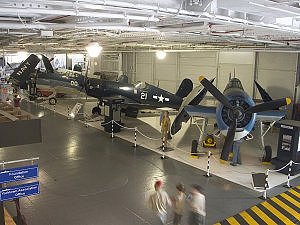Patriots Point Naval & Maritime Museum
Aircraft on the Hangar Deck
|
AD-4N is a former day time attack aircraft that has been modified to be a night attack one. It was the preferred ride of those involved in combat SAR because it could haul as much as a dump truck and stay on station a lot longer than any of the jets. Those topped with an outstanding ability to absorb Anti-Aircraft fire with little notice made this the perfect ground support aircraft as well. They were use by the USAF as their model "A-1"
|
||||||||||||
|
|
||||||||||||
|
The F4F-5 Wildcat was the continuation of Grumman naval fighters that rolled out of the Bethpage assembly line as well as those GM lines as the GM FM-2. Though outclassed by the Japanese A6M2 Zero, they held on till the F6F arrived.
|
||||||||||||
|
|
||||||||||||
|
Though envisioned as a carrier fighter, they first saw action from land based squadrons because the design of the tail wheel had them pointing so far nose high that the pilots could not see to land them on the carriers. Since they were not good enough for the Navy, they naturally were fine of the Marines and as soon as the Marines got in them, they began racking up victories. Seeing their error, the Navy had Chance-Vought redesign the tail wheel assembly at which point they became a star for both services.
|
||||||||||||
 |
||||||||||||
|
|
||||||||||||
|
The F6F Hellcat was everything that the Grumman engineers could design into them that the Wildcat lacked. They had 2 more guns, better speed, foldable wings so that more could be aboard a carrier at one time, a bigger better power plant, powered landing gear retraction and the list goes on but suffice it to say they were able to meet the current crop of Japanese fighters on much more equal terms than the Wildcats. |
||||||||||||
|
|
||||||||||||
|
The swept wing version of the F9F Series corrected many problems seen with the earlier ones.
|
||||||||||||
|
|
||||||||||||
|
The Douglas SBD Dauntless had barely reached fleet service in time to be used in the battle of the Coral Sea and Midway in the summer of 1942.
The crews were so inexperienced in using them as dive bombers that many of the leaders at Midway decided to use them as glide bombers so low and slow they were targets. At Midway they had a bit of luck on their side in that the torpedo squadrons found the four Japanese carriers first and thus pulled the defenders down from altitude before the SBD's could push over on their bombing runs. The torpedo squadrons timing kept the losses among the SBD's lower than might have been realistic to expect. |
||||||||||||